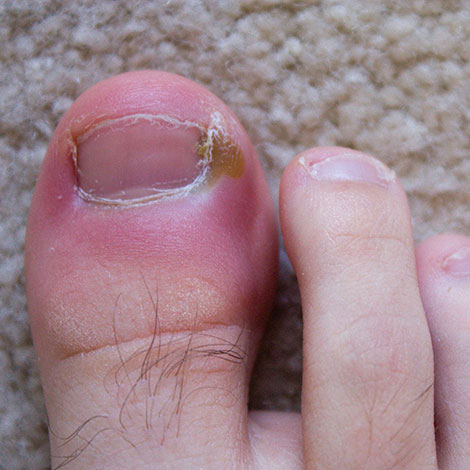Ingrowing Toenails
This presents as an acutely painful toenail problem, sometimes just located on one side of the nail, and sometimes on both sides of a nail. The toe will usually be red and warm to the touch, and there will occasionally be a discharge from the side of the nail affected. This problem requires a qualified chiropodist/podiatrist to assess it.
We will assess your general health and then, if suitable, we can recommend a small procedure called nail surgery.
This will be explained in greater detail at time of appointment, but involves numbing the toe with local anaesthetic, and then removing the side of the nail causing the problem. We then apply a chemical to the nail base to stop the nail from growing in down that side.
Symptoms include:
- A build-up of fluid in the area surrounding the toe
- An overgrowth of skin around the affected toe
- Bleeding
- Inflammation of the skin at the end of the toe
- Pain if pressure is placed on the toe
- White or yellow pus coming from the affected area
A number of things can cause an ingrown toenail to develop, including:
Badly cut toenails – cutting your toenails too short, or cutting the edges, will encourage the skin to fold over your nail and the nail to grow into the skin.
Wearing tight-fitting shoes, socks or tights – this places pressure on the skin around your toenail; the skin may be pierced if it’s pressed on to your toenail.
Sweaty feet – if the skin around your toenails is soft, it’s easier for your nail to pierce it and embed itself within it.
Injury – for example, stubbing your toe can sometimes cause an ingrown toenail to develop.
Natural shape of the nail – the sides of curved or fan-shaped toenails are more likely to press into the skin surrounding the nail.
Treating ingrown toenails
- Keep your feet clean by washing them regularly with soap and water
- Change your socks regularly
- Cut your toenails straight across to stop them digging into the surrounding skin
- Wear comfortable shoes that fit properly
Surgery may be recommended if your toenail doesn’t improve, this may involve either:
- Partial nail avulsion – removing part of your toenail
- Total nail avulsion – removing your whole toenail




